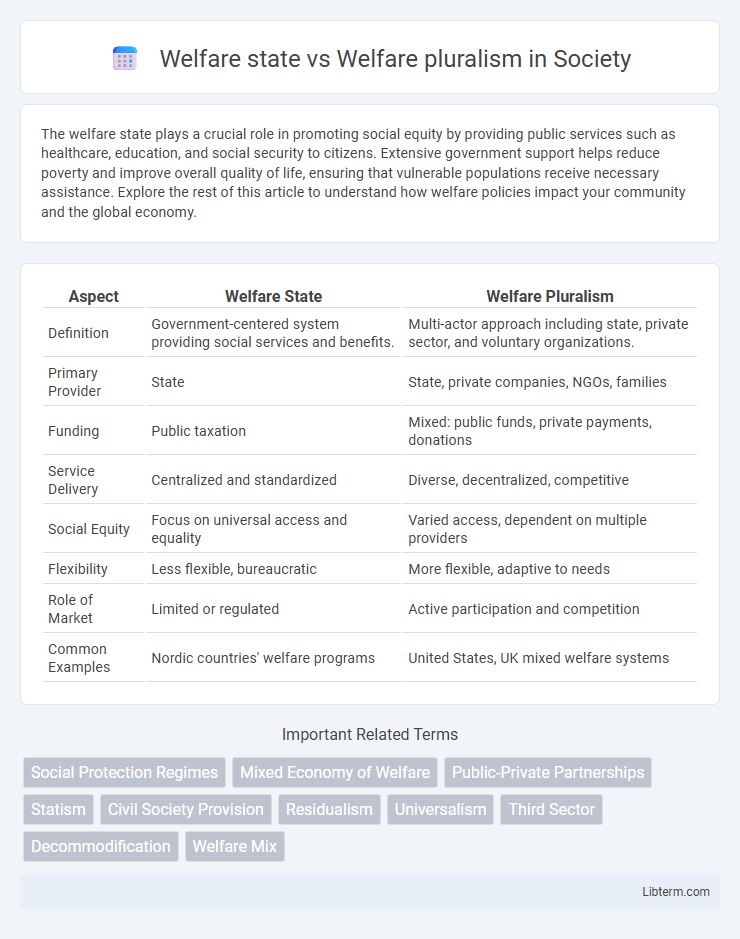The welfare state plays a crucial role in promoting social equity by providing public services such as healthcare, education, and social security to citizens. Extensive government support helps reduce poverty and improve overall quality of life, ensuring that vulnerable populations receive necessary assistance. Explore the rest of this article to understand how welfare policies impact your community and the global economy.
Table of Comparison
| Aspect | Welfare State | Welfare Pluralism |
|---|---|---|
| Definition | Government-centered system providing social services and benefits. | Multi-actor approach including state, private sector, and voluntary organizations. |
| Primary Provider | State | State, private companies, NGOs, families |
| Funding | Public taxation | Mixed: public funds, private payments, donations |
| Service Delivery | Centralized and standardized | Diverse, decentralized, competitive |
| Social Equity | Focus on universal access and equality | Varied access, dependent on multiple providers |
| Flexibility | Less flexible, bureaucratic | More flexible, adaptive to needs |
| Role of Market | Limited or regulated | Active participation and competition |
| Common Examples | Nordic countries' welfare programs | United States, UK mixed welfare systems |
Introduction to Welfare State and Welfare Pluralism
Welfare state refers to a government system that provides comprehensive social services and financial support to ensure citizens' well-being, including healthcare, education, and unemployment benefits. Welfare pluralism emphasizes the role of multiple actors--government, private sector, voluntary organizations, and families--in delivering social welfare services, reflecting a diversified approach to social support. Understanding these models highlights differences in responsibility distribution and resource allocation in social policy frameworks.
Historical Evolution of Welfare Models
Welfare state models emerged primarily in the early 20th century, centering on government responsibility for social protection through universal programs like healthcare, pensions, and unemployment insurance, with key examples in the United Kingdom and Scandinavian countries. Welfare pluralism arose in the late 20th century as a response to growing economic complexities and social diversities, advocating for multiple actors--including private sectors, non-governmental organizations, and families--to share welfare responsibilities. This shift reflects historical adaptations to globalization, fiscal pressures, and changing social values, moving away from state-centric models toward diversified welfare provision frameworks.
Defining the Welfare State: Core Features
The welfare state is characterized by government provision of universal social protection, including healthcare, education, and income support, ensuring citizens' economic security and reducing inequality. It operates through centralized policies funded by taxation, emphasizing redistributive justice and standardized benefits across populations. Welfare pluralism, in contrast, views welfare provision as a collaborative effort involving multiple actors such as the state, private sector, voluntary organizations, and families, highlighting diversity and decentralization in delivering social services.
Principles of Welfare Pluralism
Welfare pluralism emphasizes multiple providers of welfare, including the state, market, family, and voluntary organizations, promoting diversity and choice in service delivery. It operates on principles of decentralization, competition, and cooperation among various sectors to meet individual needs more efficiently and flexibly. This approach contrasts with the welfare state model by reducing state monopolies and encouraging active participation from civil society and private actors in welfare provision.
Key Differences between Welfare State and Welfare Pluralism
Welfare state primarily relies on government intervention to provide social security, healthcare, and education, ensuring universal access through centralized policies and funding. Welfare pluralism emphasizes a diversified system where multiple actors, including private sectors, non-governmental organizations, and families, share responsibilities for welfare provision, fostering competition and choice. The key difference lies in the scope of state involvement: welfare state models centralize control, while welfare pluralism promotes decentralized, heterogeneous welfare mechanisms.
Roles of Government and Non-State Actors
The welfare state primarily designates government responsibility for providing social protection through public programs and direct interventions such as healthcare, pensions, and unemployment benefits. Welfare pluralism emphasizes a diversified approach where non-state actors--including private sector entities, non-governmental organizations (NGOs), and community groups--play significant roles in delivering social services alongside government agencies. This collaborative framework enhances social welfare by combining public funding and regulation with private initiative and voluntary support mechanisms.
Case Studies: Examples from Different Countries
The welfare state model, exemplified by Sweden, emphasizes comprehensive government-funded social programs ensuring universal healthcare, education, and income support, reflecting high tax redistribution and state responsibility. In contrast, the welfare pluralism approach, seen in the United States, relies on a mix of government initiatives, private sector involvement, and non-profit organizations to deliver social services, highlighting diverse actors and limited state intervention. Case studies reveal that Nordic countries prioritize state-centric welfare systems, while welfare pluralism prevails in liberal market economies where social services are fragmented across multiple providers.
Advantages and Critiques of Welfare State
The welfare state ensures comprehensive social security by providing universal healthcare, unemployment benefits, and pensions, reducing poverty and inequality through government-funded programs. Critics argue it can lead to dependency on state aid, high taxation, and bureaucratic inefficiencies, potentially stifling individual initiative and economic growth. Despite drawbacks, extensive data demonstrates welfare states improve social cohesion and reduce economic disparities compared to systems without robust public welfare provisions.
Benefits and Challenges of Welfare Pluralism
Welfare pluralism promotes multiple providers, including state, private, and voluntary sectors, enhancing flexibility and user choice in social services. This approach benefits from diverse funding sources and innovation but faces challenges like coordination complexity and unequal access across different providers. Ensuring comprehensive coverage and quality standards remains critical for effective welfare pluralism.
Future Trends and Policy Implications
Future trends in welfare state models emphasize increasing personalization and digital integration to enhance service delivery, while welfare pluralism promotes diversified stakeholder involvement including private, nonprofit, and community sectors. Policy implications suggest a shift towards hybrid systems that balance state responsibility with market and civil society roles, fostering innovation and resilience amid demographic changes and economic pressures. This evolution demands adaptive regulatory frameworks to ensure equitable access and sustainable funding across multiple welfare providers.
Welfare state Infographic

 libterm.com
libterm.com